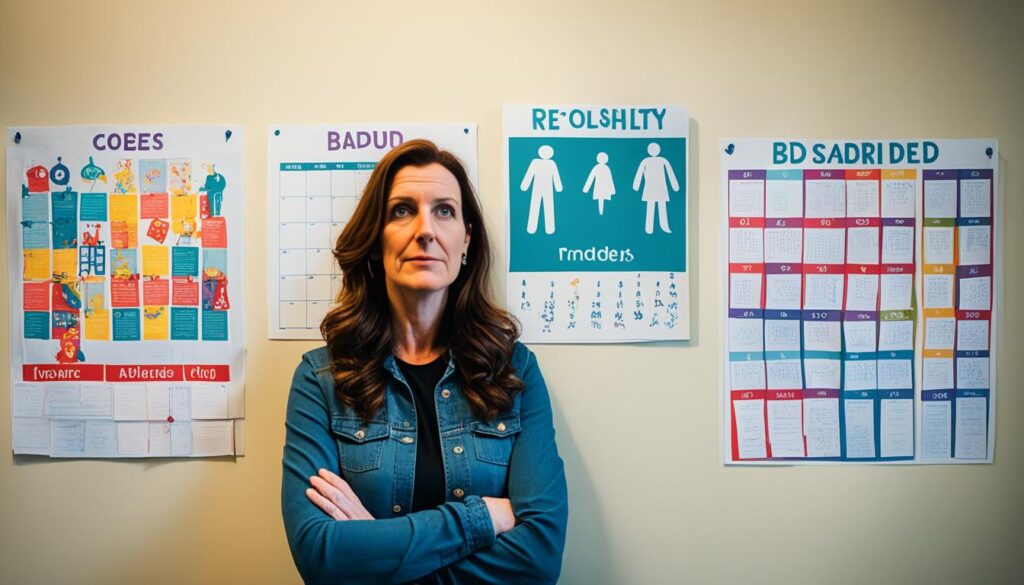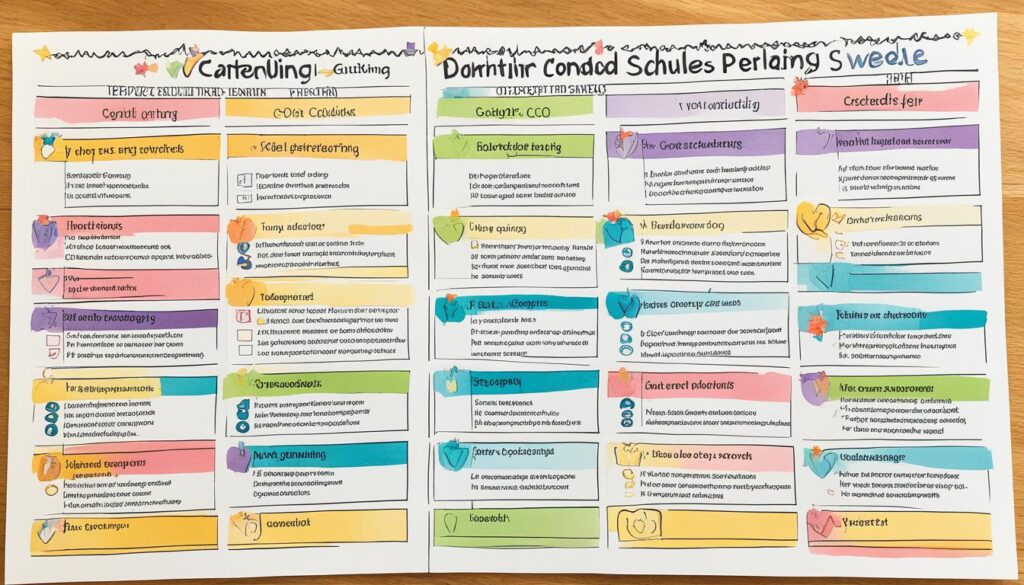Approximately 1.6% of adults in the United States have been diagnosed with Borderline Personality Disorder (BPD). This means that dealing with co-parenting responsibilities with a former partner diagnosed with borderline can be a widespread difficulty for many people.
Co-parenting with someone who has BPD can be incredibly challenging and require unique strategies to ensure the well-being of both the child and the co-parent. In this article, we will provide you with valuable tips and insights on managing co-parenting with a difficult ex-spouse who has Borderline Personality Disorder.
From effective communication strategies and setting clear boundaries to handling conflict and modifying the parenting plan, we will explore various aspects of co-parenting with a borderline ex-spouse. Our goal is to equip you with the knowledge and tools necessary to navigate this challenging situation and create a healthy co-parenting environment for you and your child.
Key Takeaways:
- Co-parenting with a borderline ex-spouse is a common challenge faced by many individuals.
- Effective communication and setting clear boundaries are crucial in co-parenting with someone who has Borderline Personality Disorder.
- Handling conflict and modifying the parenting plan can help minimize the negative impacts of co-parenting with a borderline ex-spouse.
- Prioritizing the well-being of the child and seeking professional support are essential in creating a healthy co-parenting environment.
- Co-parenting with a borderline ex-spouse requires patience, understanding, and a willingness to cooperate for the sake of the child.
Challenges of Co-parenting with a Borderline Ex-spouse
Co-parenting with a borderline ex-spouse can be a complex and demanding journey. Borderline Personality Disorder (BPD) often affects the individual’s ability to manage emotions and behaviors, making co-parenting a challenging task. To navigate these difficulties and establish a successful co-parenting dynamic, it is imperative to set clear boundaries and rules, ensuring the well-being of both parents and the child.
People with BPD commonly exhibit behavioral problems that can significantly impact the parent-child relationship. These include intense fear of abandonment, unstable interpersonal relationships, and difficulties regulating emotions. It’s crucial to recognize these challenges and take appropriate measures to minimize their adverse effects.
“Co-parenting with a borderline ex-spouse requires us to be aware of the potential behavioral problems associated with Borderline Personality Disorder. By understanding these challenges, we can actively work towards creating a healthier and more stable co-parenting environment for our child.”
Establishing clear boundaries is essential for co-parenting with a borderline ex-spouse. It helps to define acceptable behaviors and interactions, reducing opportunities for conflict and promoting a more harmonious co-parenting arrangement. By enforcing boundaries, both parents can prioritize their own well-being and ensure the child’s emotional and psychological safety.
Recognizing that co-parenting with a borderline ex-spouse may require additional support and resources is essential. Utilizing services like co-parenting counseling, support groups, and professional mediation can provide valuable guidance and assistance throughout the co-parenting journey. These resources offer a safe space to discuss challenges, navigate conflicts, and develop effective co-parenting strategies.
In summary, co-parenting with a borderline ex-spouse presents unique challenges due to the complexities associated with Borderline Personality Disorder. However, by establishing clear boundaries, understanding the potential behavioral problems, and seeking appropriate support, successful co-parenting outcomes can be achieved.
Responsibilities for the Non-BPD Parent
When co-parenting with a BPD ex-spouse, the non-BPD parent plays a crucial role in maintaining a healthy and stable environment for the child. It is essential to prioritize the child’s well-being while effectively managing conflicts and setting boundaries with the difficult ex.
1. Putting the Child First: The non-BPD parent must always prioritize the best interests of the child. By focusing on the child’s needs and ensuring their safety, emotional well-being, and development, the non-BPD parent can create a stable and nurturing environment.
2. Minimizing Conflict: Managing conflicts with a borderline ex-spouse is vital for effective co-parenting. The non-BPD parent should strive to maintain calm and avoid engaging in arguments or power struggles. Setting clear boundaries and refusing to be drawn into conflicts can help create a more peaceful co-parenting dynamic.
3. Establishing Boundaries: Setting boundaries is essential in co-parenting with a difficult ex-partner. The non-BPD parent should clearly define what is acceptable and what is not in terms of communication, behavior, and decision-making. By establishing firm boundaries, the non-BPD parent can protect their own well-being and maintain a healthy co-parenting relationship.
“Effective co-parenting with a BPD ex-spouse requires finding the right balance. Prioritizing the child’s well-being while establishing firm boundaries is key.”
4. Limiting Connection to the Ex-Spouse’s Life: It is important for the non-BPD parent to minimize involvement in the ex-spouse’s life outside of co-parenting responsibilities. This includes refraining from engaging in personal conflicts, gossip, or seeking information about the ex-spouse’s activities. By focusing solely on parenting matters, the non-BPD parent can reduce unnecessary tension and maintain a healthier co-parenting relationship.
5. Seeking Support: Parenting with a difficult ex-spouse can be emotionally challenging. The non-BPD parent should seek support from friends, family, or professionals who can provide guidance and understanding. Joining co-parenting support groups or seeking therapy can also be beneficial in navigating the complexities of co-parenting with a borderline ex-spouse.
By fulfilling these responsibilities, the non-BPD parent can contribute to a more peaceful, stable, and child-centered co-parenting arrangement.

Behavioral Problems that Hurt Parent-Child Relationships
When co-parenting with a borderline ex-spouse, it is crucial to understand how Borderline Personality Disorder (BPD) manifests and its potential impact on the parent-child relationship. BPD is characterized by intense fear of abandonment, idealization and devaluation of others, and patterns of intense relationships.
These behaviors can have a detrimental effect on the parent-child dynamic, causing distress for the child caught in the middle. It is important to be aware of the potential consequences on the child’s attachment, emotional regulation, and overall well-being.
Children who are exposed to high-conflict co-parenting and the erratic behaviors associated with BPD may experience various challenges:
- Emotional Instability: The child may be exposed to frequent and intense emotional outbursts, making it difficult for them to establish a sense of stability and security.
- Inconsistent Parenting: The BPD parent’s shifting perspectives and emotions can lead to inconsistent parenting practices, causing confusion for the child.
- Boundary Issues: The difficulty in establishing and maintaining boundaries can result in blurred lines between parent and child roles, compromising the child’s development.
- High Conflict Exposure: The child may witness ongoing disputes and conflicts between the co-parents, leading to increased stress and anxiety.
It is crucial to prioritize a child-centric co-parenting approach and focus on creating a safe and nurturing environment for the child’s growth and well-being. By understanding the unique challenges posed by high-conflict co-parenting with a borderline ex-spouse, parents can work towards mitigating the negative effects and promoting an environment that supports the child’s healthy development.
“Children who are exposed to high-conflict co-parenting and the erratic behaviors associated with BPD may experience various challenges.”
Implications for the Child
The behavioral problems associated with BPD can have long-lasting effects on the child’s well-being. They may experience difficulties in forming secure attachments, regulating emotions, and developing healthy relationships. The turmoil and instability within the co-parenting relationship can leave a lasting impact on the child’s overall development.
Recognizing these challenges and addressing them through child-centric co-parenting strategies is paramount. Providing a stable and nurturing environment, setting clear boundaries, and prioritizing the child’s needs can help mitigate the negative effects of high-conflict co-parenting with a borderline ex-spouse.

Navigating Co-parenting without a Stable Arrangement
When managing co-parenting with a borderline ex-spouse, it’s crucial to adapt and find strategies even when you don’t have a stable co-parenting arrangement. In these challenging situations, working with professionals like lawyers and therapists can provide guidance and support.
Documenting evidence of chaotic or manipulative behaviors can be essential for protecting your child and ensuring a safer co-parenting environment. Keep a record of any incidents or interactions that might be relevant to your child’s well-being. This documentation can be useful when discussing your concerns with professionals involved in your co-parenting journey.
Scheduling interactions in public settings can offer a neutral and safe environment for communication. Public spaces can help reduce tension and protect both you and your child from potentially volatile situations. Choose locations where you feel comfortable and secure, such as a local park or community center.
It’s also crucial to provide support for your child during this uncertain co-parenting journey. Take the time to listen to their thoughts and concerns. Engage in open and honest conversations that validate their emotions. Let them know that they are not alone and that you are there to support and guide them through any difficulties they may face.
A visually appealing and relevant image to this section:

Remember, navigating co-parenting without a stable arrangement can be challenging, but with effective communication and setting boundaries, it is possible to create a positive and nurturing environment for your child.
How Personality Disorders Impact Custody Decisions
When determining custody arrangements, courts take into account various factors, including the impact of personality disorders on the well-being of the child. One such personality disorder that can significantly affect custody decisions is Borderline Personality Disorder (BPD).
BPD can affect a parent’s ability to provide a stable and nurturing environment for their child. In some cases, the courts may require additional evidence to support custody decisions. Admissible evidence, such as a history of arrests or unstable employment, can demonstrate the potential risks associated with the BPD parent’s parenting abilities.
In certain situations, a mental-health evaluation of the BPD parent may be necessary to assess their ability to meet the child’s needs and ensure their overall safety and well-being.
Implications for Custody Arrangements
The presence of a personality disorder, such as BPD, can have significant implications for custody arrangements. Courts strive to make decisions that prioritize the child’s best interests and safety. They may allocate custody in a way that minimizes the potential negative impacts of the BPD parent’s behaviors and provides a more stable environment for the child.
Here is an example of a possible custody arrangement:
| Parent | Custody Schedule |
|---|---|
| Non-BPD Parent | Primary physical custody |
| BPD Parent | Supervised visitation |
In this arrangement, the non-BPD parent assumes primary physical custody to ensure the child’s well-being and stability. The BPD parent is granted supervised visitation to ensure the child’s safety and minimize any potential harm. This arrangement aims to balance the child’s need for a relationship with both parents while prioritizing their safety and emotional well-being.
Counseling and Support Groups
Navigating co-parenting dynamics with a BPD ex-spouse can be challenging. Seeking co-parenting counseling and joining co-parenting support groups can provide valuable guidance, insights, and coping strategies for managing these unique challenges. These resources offer a supportive community where individuals can share their experiences and learn from others facing similar situations.
Additionally, co-parenting counseling can help parents develop effective communication strategies, set appropriate boundaries, and manage conflicts that may arise during the co-parenting process. These tools can contribute to healthier and more cooperative co-parenting relationships, benefiting both parents and the child.
By seeking professional help and finding support within co-parenting counseling and support groups, individuals can gain valuable resources and insights to navigate the complexities of co-parenting with a BPD ex-spouse.

Custody Schedules to Support the Child of a BPD Parent
When co-parenting with a borderline ex-spouse, it is essential to establish custody schedules that prioritize the child’s well-being while considering the challenges of a parent with Borderline Personality Disorder (BPD). By modifying the custody arrangement, it is possible to provide support and create a stable environment for the child.
We recommend incorporating the following strategies into your custody schedule:
- Allow for other role models and caregivers: To compensate for any potential parenting deficiencies, it can be beneficial to involve other trusted individuals in the child’s life. This can include grandparents, aunts, uncles, or close family friends who can provide additional support and stability.
- Designate the non-BPD co-parent as the primary caregiver: Given the challenges associated with BPD, it is often in the child’s best interest to have the non-BPD co-parent take on the primary caregiving role. This ensures that the child has a consistent and stable presence in their life.
- Include shorter visits and frequent changeovers: To minimize potential conflict and maintain a sense of stability, consider incorporating shorter visitation periods and more frequent changeovers between co-parents. This can help prevent the child from becoming overwhelmed and create a smoother transition between households.
- Maintain frequent communication with the non-BPD co-parent: Effective communication between co-parents is vital when managing co-parenting with a borderline ex-spouse. Regular check-ins and open lines of communication can help address any concerns or issues promptly and ensure that the child’s needs are consistently met.
Creating a custody schedule that supports the child of a BPD parent requires careful consideration and effective communication between co-parents. By incorporating these strategies into your custody arrangement, you can provide the necessary support and stability for your child’s well-being.

Elements to Consider in a Custody Schedule Modification
| Element | Description |
|---|---|
| Role models and caregivers | Identify trusted individuals who can provide additional support and stability in the child’s life. |
| Primary caregiver | Designate the non-BPD co-parent as the primary caregiver to ensure consistency and stability. |
| Visitation duration | Incorporate shorter visits to prevent overwhelm and frequent changeovers to ensure a smooth transition. |
| Communication | Maintain open lines of communication between co-parents to address concerns and meet the child’s needs. |
Remember, every custody arrangement is unique, and it’s essential to tailor the modifications to your specific situation and the needs of your child. Consulting with a legal professional or a co-parenting counselor can provide valuable guidance and help navigate the complexities of managing co-parenting with a borderline ex-spouse.
Modifying the Parenting Plan to Limit Potential Harm
When co-parenting with a borderline ex-spouse, it is crucial to modify the parenting plan to address potential issues that could harm the child. By including provisions that specifically address the behaviors associated with Borderline Personality Disorder (BPD), both parents can establish clear expectations and boundaries for effective co-parenting communication.
Creating a Comprehensive Parenting Plan
A comprehensive parenting plan is the foundation for successful co-parenting. It should outline the roles and responsibilities of each parent, as well as specific strategies for managing conflict and parallel parenting. Assigning clear responsibilities and expectations in the plan can reduce the need for ongoing discussion and negotiation, minimizing potential conflicts.
By having a well-defined parenting plan, we can effectively manage co-parenting with a borderline ex-spouse and ensure a nurturing environment for our child.
Addressing BPD Behaviors in the Plan
When modifying the parenting plan, it is important to address the specific behaviors associated with BPD. These behaviors can include intense emotions, impulsive actions, and difficulty regulating relationships. By acknowledging these challenges in the plan, both parents can work together to create strategies for managing conflicts and mitigating the potential impact on the child.
For example, the plan may include guidelines for managing conflict, such as utilizing parallel parenting techniques when direct communication becomes challenging. This allows parents to focus on co-parenting tasks while minimizing direct conflicts that may arise due to the ex-spouse’s BPD symptoms.
Striking a Balance Between Flexibility and Boundaries
While flexibility is important in co-parenting, it is equally crucial to establish firm boundaries that protect the child’s well-being. The parenting plan should outline boundaries for communication, decision-making, and visitation schedules. Striking the right balance between flexibility and boundaries ensures that the child’s best interests are prioritized while managing potential conflicts.
Remember, modifying the parenting plan is an ongoing process. As the child grows and circumstances change, it may be necessary to revisit and modify the plan accordingly, always with the child’s best interests in mind.
| Benefits of Modifying the Parenting Plan | How it Helps |
|---|---|
| 1. Clarifies expectations | Ensures both parents understand their roles and responsibilities. |
| 2. Reduces conflicts | Establishes guidelines for communication and conflict management. |
| 3. Provides stability | Creates a predictable routine for the child, minimizing the impact of BPD-related behaviors. |
| 4. Protects the child’s well-being | Sets boundaries and safeguards against potential harm caused by BPD symptoms. |

Conclusion
Co-parenting with a borderline ex-spouse can be a challenging journey, but it is not insurmountable. By implementing the right strategies and seeking the necessary support, we can create a healthy co-parenting environment for ourselves and our children. One crucial aspect of successful co-parenting is seeking professional help. Therapists and counselors specialized in co-parenting can provide valuable guidance and techniques to navigate the complexities of co-parenting with a borderline ex-spouse.
Establishing clear boundaries is another key factor in successful co-parenting. By setting boundaries, we can create structure and stability, minimize conflict, and prioritize the well-being of our children. Boundaries can include guidelines for communication, decision-making, and setting expectations for both parents. When we establish and enforce these boundaries consistently, we create a more positive co-parenting dynamic.
While co-parenting with a borderline ex-spouse can be challenging, we are not alone in this journey. There are numerous co-parenting support groups and resources available. Utilizing these resources can provide us with the guidance, encouragement, and understanding we need. Co-parenting support groups and counseling can connect us with others who are facing similar challenges, offering a sense of community and reassurance that we are not alone.
In conclusion, successful co-parenting with a borderline ex-spouse requires a combination of professional help, setting boundaries, and utilizing available resources. By prioritizing our children’s well-being and remaining dedicated to creating a healthy co-parenting environment, we can navigate the challenges and provide the stability and support our children need to thrive.
FAQ
What are some co-parenting strategies for managing a difficult ex-spouse?
Setting clear boundaries, prioritizing the child’s well-being, and seeking professional help, such as co-parenting counseling, can be beneficial. Additionally, utilizing resources like co-parenting support groups can provide guidance and support throughout the co-parenting journey.
How does Borderline Personality Disorder (BPD) impact the co-parenting relationship?
BPD can make co-parenting challenging due to difficulties managing emotions and behaviors. It is important to understand BPD’s impact on the parent-child relationship and to establish boundaries and clear rules for co-parenting interactions.
How can the non-BPD parent successfully co-parent with a borderline ex-spouse?
Prioritizing the child’s well-being while considering the limitations and potential endangerment associated with a BPD parent is crucial. Establishing solid boundaries, minimizing connection to the ex-spouse’s life, and seeking professional support can help maintain peace and cooperation.
What are some common behavioral problems associated with BPD that can hurt the parent-child relationship?
BPD behaviors, such as intense fear of abandonment and unstable relationships, can negatively impact the parent-child relationship. It is important to be aware of these behaviors and their potential effects on the child’s attachment, emotional regulation, and overall well-being.
How can co-parenting be navigated without a stable arrangement?
Working with professionals, scheduling interactions in public settings, documenting evidence of problematic behaviors, and providing support for the child can help create a safer co-parenting environment when there is no stable co-parenting arrangement.
How do personality disorders, including BPD, impact custody decisions?
Courts consider the potential negative impacts of personality disorders on a child’s well-being when making custody arrangements. Gathering admissible evidence, such as a history of arrests or unstable employment, can support custody decisions. In some cases, a mental health evaluation of the BPD parent may be necessary.
How can custody schedules be modified to support children with a BPD parent?
Allowing for other role models and caregivers in the child’s life can help compensate for potential parenting deficiencies associated with a BPD parent. Custody schedules should prioritize the non-BPD co-parent as the primary caregiver and include shorter visits and frequent changeovers to benefit the child’s well-being.
How can the parenting plan be modified to limit potential harm caused by a BPD parent?
Modifying the parenting plan to include provisions that address the BPD parent’s behaviors and set clear expectations for both parents can reduce the need for ongoing discussion and negotiation. Balancing flexibility with clear boundaries is essential for a successful co-parenting dynamic.
How can co-parenting with a borderline ex-spouse be made easier?
Seeking professional help, establishing boundaries, prioritizing the child’s well-being, and utilizing resources such as co-parenting support groups and counseling can all contribute to a healthier and more successful co-parenting environment.









